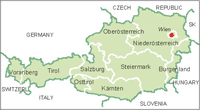
About Salzkammergut
 The Salzkammergut is not a federal province, but an area shared between Salzburg and more so Upper Austria and Styria. It stretches from City of Salzburg to the Dachstein mountain range. The main river of the region is the Traun, a tributary of the Danube.
The Salzkammergut is not a federal province, but an area shared between Salzburg and more so Upper Austria and Styria. It stretches from City of Salzburg to the Dachstein mountain range. The main river of the region is the Traun, a tributary of the Danube.It is among Austria′s top-tourist attractions and individual areas within the Salzkammergut are jointly a UNESCO World Cultural Heritage Site in 1997.
The Salzkammergut is famous for its scenery, picturesque villages and many lakes. It also has a very distinct culture, expressed in architecture, customs (including the traditional clothing) and cuisine.
The name Salzkammergut means "Estate of the Salt Chamber" and derives from the Imperial Salt Chamber, the authority charged with running the precious salt mines in the Habsburg empire.
 Human activity in Salzkammergut began in prehistoric times, with the salt deposits being exploited as early as the 2nd millennium B.C. This resource formed the basis of the area's prosperity up to the middle of the 20th century, a prosperity that is reflected in the fine architecture of the town of Hallstatt.
Human activity in Salzkammergut began in prehistoric times, with the salt deposits being exploited as early as the 2nd millennium B.C. This resource formed the basis of the area's prosperity up to the middle of the 20th century, a prosperity that is reflected in the fine architecture of the town of Hallstatt. The Salzkammergut consists of ten regions: Almtal, Attergau, Attersee, Bad Ischl, Traunsee, Wolfgangsee, Dachstein Salzkammergut, MondseeLand, Fuschlsee, Ausseerland – Salzkammergut.
 Back to top
Back to top


 Romana
Romana English
English











